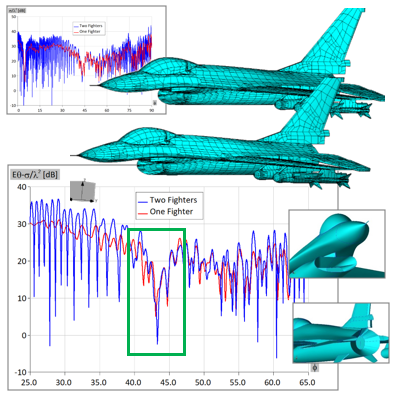The Radar Shadow
19-Nov-2018

19-Nov-2018
 Here we consider a situation where a surveillance radar is illuminating a zone where two aircrafts are approaching. In such a situation, a radar shadow can be utilized to deceive the radar system as it perceives only one aircraft approaching a target zone. Only the electromagnetic (EM) aspects of the simulated radar shadow scenario is investigated, i.e. only the monostatic scattering regardless the coding of the signal, frequency hopping, or some other radar system related feature. The single frequency analysis of this radar shadow scenario will be sufficient to draw the important conclusions.
Here we consider a situation where a surveillance radar is illuminating a zone where two aircrafts are approaching. In such a situation, a radar shadow can be utilized to deceive the radar system as it perceives only one aircraft approaching a target zone. Only the electromagnetic (EM) aspects of the simulated radar shadow scenario is investigated, i.e. only the monostatic scattering regardless the coding of the signal, frequency hopping, or some other radar system related feature. The single frequency analysis of this radar shadow scenario will be sufficient to draw the important conclusions.
This application note explains manipulations and modifications of a fighter aircraft CAD model required to prepare it for the simulations. Then, the CAD model is meshed. The second aircraft is added to the modelling scenario in the next step and monostatic scattering is calculated for both of the scenarios – the first where only one aircraft is present, and the second where two aircrafts are included. In the two-aircraft scenario, the aircrafts are positioned so that for the case of the radar illumination from the angle of 45 Degrees one of the aircrafts remains hidden as it lays in the shadow created by another aircraft. The scenarios are simulated at 1.3 GHz, which is widely used frequency in radar surveillance. WIPL-D software, the full wave 3D EM Method-of-Moments (MoM) based solver which uses sophisticated higher order basis functions (HOBFs), is successfully used for simulation of this radar shadow scenario. The simulations of this demanding and electrically large radar shadow scenario are performed using WIPL-D software without applying any reduction of the number of unknowns. All the simulations are performed with acceptable simulation times.
Section: RCS/Scattering
For full version of the document, please check the following pdf.